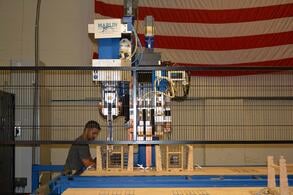 Here at Marlin Steel, we’re pretty big fans of automation and new technology in general. In many cases, advancements in manufacturing technology help us to be more efficient and competitive in an ever-changing market. As a matter of fact, our investments in automated manufacturing equipment have helped to turn this company around from the brink of doom, expanding the markets we serve and allowing us to mass-produce custom metal products with incredibly tight tolerances.
Here at Marlin Steel, we’re pretty big fans of automation and new technology in general. In many cases, advancements in manufacturing technology help us to be more efficient and competitive in an ever-changing market. As a matter of fact, our investments in automated manufacturing equipment have helped to turn this company around from the brink of doom, expanding the markets we serve and allowing us to mass-produce custom metal products with incredibly tight tolerances.
However, technology can sometimes be a bit more… disruptive to specific businesses. In an Inc.com article titled “Disruptors: Are You Adaptable Enough to Handle the 12 Big Technologies That Will Rock Our World?” Inc. columnist and Marlin Steel CEO Drew Greenblatt tackles the dark side of technological advancement.
Disruptive Technology in the Past
For an example of how a new technology can render an old business nearly totally obsolete, Drew introduced one famous example of a disruptive technology and its impact on businesses, both for good and for ill: the automobile.
Before the introduction of the automobile (and, to a lesser extent, the locomotive train), the primary method of transit over long stretches of land was by horse or carriage. This ensured a steady, profitable business for horse breeders and a myriad of related businesses, such as horseshoe makers, saddle producers, feed growers, and veterinary doctors specializing in equine health, among others. However, when the car replaced the horse as the fastest, most economical way for the family to get around, many of these businesses and specialists who had tailored themselves to this one, singular niche industry found themselves losing business in droves to the old, mass-produced Model T.
However, while many of those who couldn’t adapt to the change in the market lost their jobs and their livelihoods, many more jobs were created to support this new technology. While more tireless than a horse for any single drive, cars still required regular maintenance, new tires, constant safety upgrades and design revisions, fuel, and paved roads to run on. In the balance, the disruptive technology of the car actually created millions of new jobs to replace the thousands that were lost when the vast majority of the horse and carriage business faded.
Tech to Watch out for: The McKinsey Global Institute Report
With the benefit of computer-aided modeling technology and the sheer amount of knowledge that can be quickly and easily shared on the internet, new innovations seem to be coming at businesses faster than ever before. In a recent report published by the McKinsey Global Institute, 12 up and coming technologies are identified as having the potential to dramatically change the business world (in fact, some already are).
Six of these technologies are:
- Cloud Data Storage- This is a technology that many businesses and private citizens use daily. Here at Marlin Steel, we back up all of our data four times per hour or more to “the cloud.” By storing a copy of our data on a remote server, we can be prepared for sudden, unexpected disasters that might wipe out our local computers and their data. With cloud-based data storage, our company doesn’t have to handle the maintenance of dozens of on-site servers, streamlining costs and operational headaches.
- Automation of Knowledge Work- A simple computer program can follow the directions it’s given repeatedly and reliably. However, a normal computer program can’t think or solve problems without being given exact parameters first. A true artificial intelligence, on the other hand, can find patterns on its own and make improvements accordingly, optimizing existing systems for efficiency.
- Mobile Internet Technology- Every day, you can see more and more internet-ready mobile devices being used by people. For businesses, leveraging mobile technology to give employees access to critical data or even the ability to control certain automation equipment while on the go can be a powerful tool for increasing efficiency.
- Advanced Robotics- As the programs on our automated rigs becomes more sophisticated, and the automated robots themselves become more capable, we may soon see fantastically capable automated assembly robots that can operate almost entirely independent of an operator.
- Autonomous or Nearly Autonomous Vehicles- This is a concept that has been in the works for a while. From cars that can detect the paint lines in the road and provide course correction assistance based on that, to more advanced concept cars that will one day eliminate the need for a human driver, this is a technology that can revolutionize the transport of goods from one place to another. In the Inc.com article, Drew cites the exciting possibility of big rig robot trucks that will be able to run 24 hours a day without stopping for anything but gas on the way.
- 3D Printing- Though still largely in its infancy, 3D printing is set to be one of the single biggest disruptive technologies on the horizon. Imagine being able to “print” an object of any shape or size within a given set of dimensions, without having to make special tooling first. All you would need is a detailed 3D image file of the object you needed, and it could be printed straight away. Right now, however, the limitations in what materials can be used in the process and the time it takes for a single print to complete limit this technology from replacing all forms of traditional manufacturing.
Read the full Inc.com article to learn more about the other six disruptive technologies on the horizon.



.gif)


